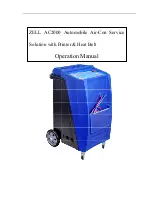
96-0012 rev G
17
June 2003
O
M
PERATOR’S
ANUAL
A u t o m a t i c
A u t o m a t i c
A u t o m a t i c
A u t o m a t i c
P a l l e t C h a n g e r
P a l l e t C h a n g e r
P
ROGRAMMING
FOR
FMS
Using an M50 code in the parts program runs the pallet change routine. In order for M50 to work correctly the
APC load and unload coordinate must be set for each pallet (settings 121 through 128 and 146-153. Make sure
that the X coordinate safe distances, setting 129 and setting 154, are set correctly. See Table for correct X
coordinate safe distances.
Safe Distance Settings Table
Pallets 1 & 2
Pallets 3 & 4
Setting 129
Setting 146
X safe distance
X safe distance
(inches)
(inches)
VF-3
-33.000
-7.00
VF-4
-43.000
-7.00
The APC can be programmed to run the same parts program on all pallets, or a different program on each
pallet. See “Sample Programs” for some of the options available for pallet change programming.
For the Dual APC to perform automatic pallet sequencing and part program selection, each pallet must be
“scheduled” and must have a parts program assigned to it. Scheduling is done in two ways. A pallet can be
scheduled with its SCHEDULE PALLET button on the operator’s panel. Pushing the button schedules the
pallets in the sequence they are pushed.
The pallets can also be scheduled from the Pallet Schedule Table (PST) display. This display can be found by
pressing the CURNT COMDS key and then pressing the PAGE UP or PAGE DOWN keys until the Pallet
Schedule Table page is reached. The pallets can be scheduled from this display by using the arrow keys to
highlight the “Load Order” box for the pallet. With the cursor in the correct box, enter a number 1,2,3, or 4 by
keying the number and then the WRITE key. If there is already a priority number for that pallet, the
“Load Order” numbers of the other pallets will be updated as necessary. A pallet that is in the receiver will have
an asterisk in the “Load Order” column.
The home position for each pallet is as follows: Pallet 1, tp the right and closest to the control pendant. Pallet
2, to the right and furthest fom the control pendant. Pallet 3, to the left and furthest form the control pendant.
Pallet 4 to the left and closest to the control pendant.
As mentioned above, a pallet must have a parts program assigned to it. Assigning a part program is also done
in the PST display. The arrow keys are used to highlight the “Program Number” box for the pallet. The program
number is entered by keying the number and then pressing the WRITE key. For example, keying
O123
, then
WRITE
will put the program number O00123 into the table.
If a parts program encounters an M50 (without a P code) and none of the SCHEDULE PALLET buttons have
been pressed, the VMC control will pause operation, the beacon will blink green, and the message “NONE
SCHEDULED” will appear on the screen. The VMC will wait until a SCHEDULE PALLET button has been
pressed, or the PST has been updated, before performing the pallet change. This feature prevents a pallet
change from occurring before the operator is ready. The SCHEDULE PALLET button can be pressed at any
time and will be recognized when the next pallet change is required.
Pallets can also be changed without automatic sequencing or PST inputs. This is done using M50 with a P
code. M50 P1 will load pallet #1 without checking to see if it is scheduled. M36 P1 before the M50 P1 will
check that pallet #1 is ready. If the SCHEDULE PALLET button has been pressed, the pallet #1 will be loaded.
If the SCHEDULE PALLET button for pallet #1 has not been pressed, the indicator light on the button will flash
and the VMC control will flash “SCHEDULE PAL#1”.
PROGRAMMING
















































